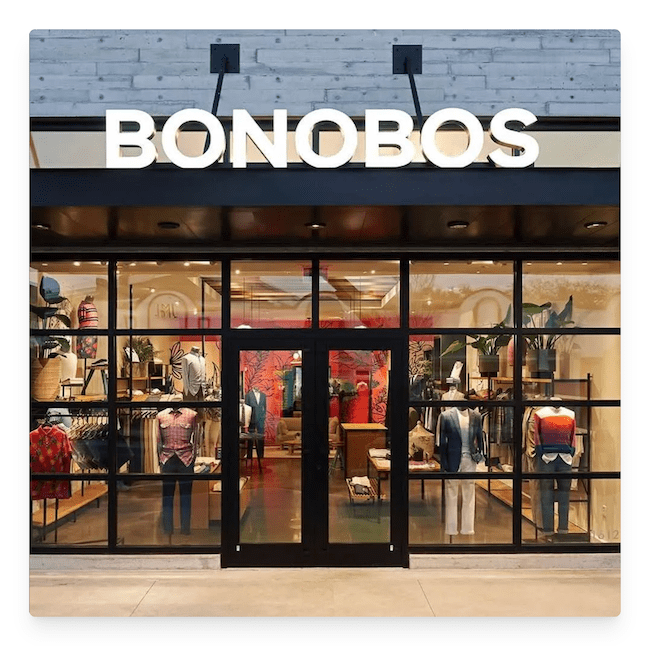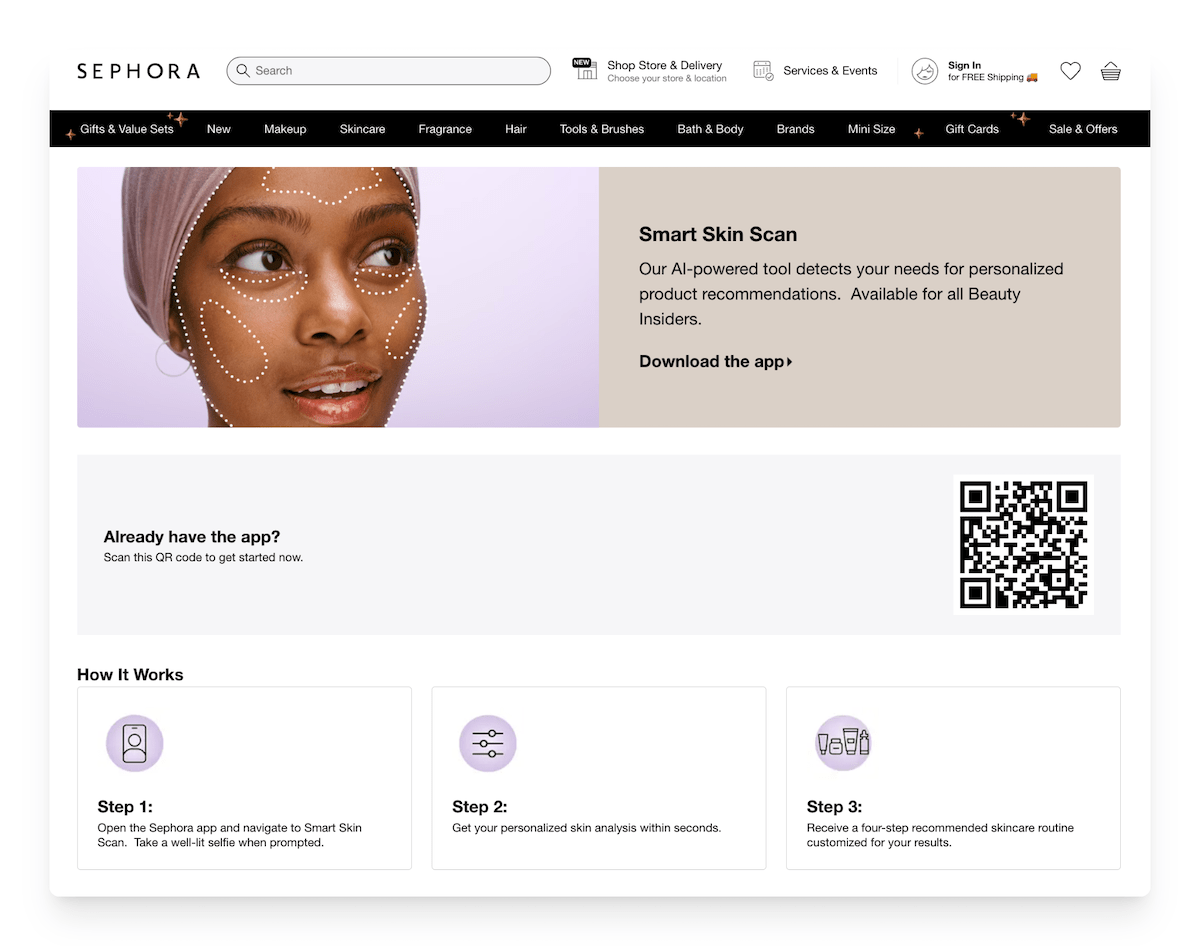Key points in this article:
- DNVBs are brands born on the internet, which sell directly to their customers.
- They control everything: production, communication, and the shopping experience.
- Advantages: more freedom, closer customer relationships, and higher margins.
- Limitations: dependence on digital technology, complex logistics and strong competition.
- Examples: Sézane, Allbirds, Casper, Glossier, Warby Parker, Cabaïa, and Gymshark.
No flashy TV ads, no huge marketing budgets, no stores all over the country. And yet, you’re bound to know them!
They’re known as Sézane, Allbirds, Casper, Glossier, and many more. These are brands that were born on the internet and became household names without ever going through traditional communication or distribution channels (at least in the beginning).
These companies are called DNVBs, or digitally native vertical brands. They’re brands designed from the outset for the digital world, selling directly to their customers and controlling their entire value chain, from the product to the shopping experience.
They’ve built their success by injecting meaning into their actions, transparency, and proximity via online commerce.
These brands are flourishing on the web, but at what cost? Let’s take a quick look at the advantages and disadvantages of these gems that are worth watching!
Definition of the term DNVB
A DNVB (digital native vertical brand) is a brand born on the internet. It sells its products directly to its customers, without intermediaries, and controls the entire process, from manufacturing to customer relations.
DNVB is a concept that emerged in the United States in the 2010s and was popularized by Andy Dunn, founder of Bonobos.
→ Read also: Ecommerce in the USA

A DNVB is, above all, a brand specifically designed for online commerce sales.
These brands, born in the internet age, have built their identity and growth through digital marketing, social media, and all the tools of the web. Each product is designed for consumers who are digitally savvy and attentive to the transparency of values and products, as well as the quality and ethics of the brand they choose.
DNVBs understand what consumers care about and adapt to them in real time using web data.
In France alone, according to FEVAD data, there are now more than 700 DNVBs (715 exactly in 2022, compared to 592 in 2021 and 344 in 2019). Their average turnover reached €5.48 million in 2022, up 19% from the previous year.
What are the advantages of DNVBs?
Total control over the brand
Unlike traditional brands that depend on distributors, retailers, or physical intermediaries, DNVBs are a form of ecommerce that controls the entire production and sales process.
Verticality is evident here, allowing the retail company to control every stage of the product journey: from design to delivery, including distribution and customer service.
A vertical and virtuous concept:
- It guarantees consistent product quality, as the company directly controls manufacturing.
- It allows collections to be quickly adapted based on direct customer feedback.
- It ensures overall consistency between the brand identity and the consumer’s shopping experience.
This autonomy is a major strategic asset. By eliminating intermediaries, DNVB companies avoid diluting their message and can adjust their market positioning, change their prices, test new products, or launch collaborations without depending on an external distribution network.
A direct relationship with the customer
Direct-to-consumer (DTC) sales eliminate all filters: there’s no longer an intermediary between the brand and the customer. This approach makes it possible to build an authentic, personalized, and evolving customer relationship that goes beyond a simple commercial transaction.
Thanks to digital tools such as social media, newsletters, and instant messaging, DNVB brands maintain a constant dialogue with their customers, making it easier to learn how to better their product range and service offerings.
According to Payplug’s DNVB barometer, digital marketing is at the heart of the concept, with 30% of revenue spent on average by brands and 23% of DNVBs having a main source of organic acquisition (SEO or traditional word-of-mouth marketing).
This ongoing conversation goes far beyond a simple business exchange, as it fosters a genuine relationship of trust, built on listening and close collaboration.
By observing feedback, analyzing data, and remaining attentive to needs, these digitally native companies gain a precise understanding of what their customers expect from them.
This allows them to design more relevant products, often inspired by or co-created with their followers.
Higher margins
According to Payplug data, 71% of DNVBs are self-financed.
By eliminating intermediaries such as retailers and wholesalers, brands born on the internet achieve huge savings on distribution and logistics.
DNVB companies retain complete control over their sales channels because they sell their products directly on their own websites.
This allows them to limit the expenses associated with commissions and margins imposed by retailers, while increasing their profits.
By managing the entire value chain themselves, from production to delivery, they optimize each step of the process and benefit from better control over volumes, prices, and quality.
This comprehensive control gives them the freedom to adjust their strategy in real time, maintain fair prices for their customers, and generate higher margins without compromising product quality or the overall brand experience.
A tailor-made customer experience
For a digital native vertical brand, customer experience isn’t just a marketing argument—it’s the foundation of the model.
The entire DNVB brand ecosystem is designed around the customer, from browsing the website to opening the package.
There is a desire to put people back at the center of online sales, by viewing online shopping as a holistic experience rather than a simple, anecdotal transaction.
Every point of contact counts. These include the following:
- customer service,
- fluidity of the ecommerce platform,
- design of the packaging,
- transparency of messages,
- speed of delivery,
- etc.
Faster growth
DNVB companies have the ability to reach a global audience in just a few months, without having to invest in physical distribution networks.
They can test new markets and roll out large-scale digital marketing campaigns without opening a single point of sale.
Their lean structure and mastery of digital tools facilitate the automation of actions that enable them to become stronger (inventory management, marketing, customer service, reporting, or advertising campaigns on social media).
The DNVB business model, based on direct-to-consumer sales and the optimization of digital channels, allows them to expand their international presence without the logistical, financial, and administrative constraints of traditional brands.
Once again using the Payplug DNVB barometer data, more than 56% of DNVBs already sell internationally, where they generate approximately 16% of their revenue.
A model designed for the new generations
Digital native vertical brands also respond to a profound change in consumer behavior. In a context where customers are looking for greater transparency, DNVB brands offer a new philosophy of online commerce.
This digital native vertical model promotes strong values such as local or sustainable production, short supply chains, and the promise of sustainability.
The average age of DNVB consumers is 33 years old, and the most represented segments are 25–34 years old (38.6%) followed by 35–44 years old (29.7%), based on Payplug data.
DNVBs meet this expectation by placing customer relations at the center of their business and working to build engaged communities, not around a single product, but around their overall concept as a powerful brand.
What are the disadvantages of DNVBs?
Being a DNVB has some significant limitations, but these can be easily managed with the right partners!
A strong dependence on digital
Being a “digital native” means depending on the rules imposed by the web giants. A DNVB remains subject to the algorithms of Google, Meta, or TikTok, which can change overnight and heavily impact a brand's visibility.
There are also the risks of the web, such as technical bugs or changes in online platform policies, which can quickly jeopardize an entirely online business.
This is why many DNVBs are now choosing to diversify their channels so as not to put all their eggs in one basket with digital and to move away from the “pure player” model (physical stores, sales in supermarkets, marketplaces).
Complex logistics to master
While digital technology simplifies sales, it doesn’t eliminate the physical reality of products (production, storage, delivery, returns, etc.).
Managing the entire supply chain without intermediaries requires solid logistics expertise.
And when a DNVB experiences rapid growth, these elements become even more demanding. It can’t cut corners in this area because the survival of its brand depends on it!
Constant innovation
The DNVB model relies on freshness and creativity to truly differentiate itself from traditional brands.
But in a market where digital norms are rapidly becoming standardized, staying original requires extra effort.
To keep their customers’ attention and loyalty, brands must always stay one step ahead of the competition and launch new products or innovate in their communication. This requirement can be costly and difficult to maintain over time, but it isn’t impossible.
→ Read also: Ecommerce innovations
Growth that is sometimes difficult to monetize
The myth of the profitable DNVB growing at breakneck speed hides a more nuanced reality. Yes, because growing fast doesn’t always mean earning more.
The risk is experiencing strong growth due to digital notoriety, before running into excessively low margins and skyrocketing fixed costs.
Upstream, the entrepreneur at the head of the DNVB must structure the business model from the outset (clear margins, pricing strategy, and balance between acquisition and retention). Because, as we know, retaining a customer costs less than recruiting new ones in ecommerce!
Competition in the same segments
The success of DNVBs has inspired a whole wave of entrepreneurs and major brands. Traditional retailers are now investing in the digital arena with digital strategies, often backed by huge marketing budgets.
DNVBs find themselves competing for the same audiences as large groups, but without the same resources.
For example, brands such as Typology, which started out as a pure DNVB in the beauty sector, have built their reputation on Instagram, with minimalist packaging and specific online resources such as personalized skin diagnostics.

But on the other hand, Sephora has taken inspiration from the playbooks of these trendy and fashionable brands (branding, influencer marketing, storytelling) with, in particular, similar services that are even more advanced in stores.

Differentiation is becoming a key issue for these brands, which know that only those with a strong identity will be able to succeed in the long term!
Advantages
Total control over production, distribution, and communication
Direct and authentic relationship with customers
Higher profit margins thanks to the elimination of intermediaries
Customized customer experience consistent with brand identity
Rapid and flexible international growth
A model aligned with the expectations of new generations (values, transparency, sustainability)
Disadvantages
Strong dependence on digital channels and platform algorithms
Complex logistics management (production, delivery, returns…)
Need to constantly innovate in order to stand out
Rapid growth, but sometimes difficult to make profitable
Competition from major brands that are adopting DNVB (digitally native vertical brand) models
DNVB examples
Sézane

Founded in 2013 by Morgane Sézalory, Sézane is undoubtedly one of the most fashionable French digital native vertical brands (DNVBs).
Designed entirely for internet commerce, Sézane has built a committed community around its values.
A distinctive Parisian design and a model of limited-edition collections, available exclusively online or in its “Sézane Appartements,” have created a sense of exclusivity and a strong desire to buy among customers.
Allbirds

Launched in 2016 by Tim Brown and Joey Zwillinger, Allbirds captures the essence of the modern eco-minded DNVB: simplicity, sustainability, and quiet confidence.
The retail company built its reputation on natural materials—most famously merino wool—and a promise of radical transparency that resonates with consumers craving responsibility over flash.
Behind its minimalist aesthetic, Allbirds relies on a sharp marketing playbook rooted in purpose-driven storytelling, community engagement, and a strong, steady presence across digital platforms.
Casper

Casper shook up the sleepy mattress industry when founded in 2014 with a simple promise: great rest without the gimmicks.
The direct-to-consumer (DTC) company quickly became a DNVB favorite thanks to its famously comfy “one perfect mattress,” a breezy buying experience, and a knack for blending humor with genuine expertise.
With its playful voice, smart design choices, and focus on customer delight, Casper turned an everyday product into a surprisingly fun, modern lifestyle essential.
Glossier

Glossier grew from Emily Weiss’s beloved beauty blog Into the Gloss, launched in 2010, where real routines and honest conversations sparked a devoted community.
In 2014, she transformed that momentum into Glossier, a digital-native brand built on listening first and creating second.
Featuring minimalist staples, photogenic packaging, and an effortless, real-skin philosophy, Glossier continues to reshape modern beauty and the way people connect with it.
Warby Parker

Warby Parker got its start in web commerce in 2010 when Neil Blumenthal, Dave Gilboa, Andrew Hunt, and Jeffrey Raider set out to shake up the eyewear world with fair prices, sharp design, and a transparent online model.
What began as a straightforward way to buy great glasses without the markup quickly evolved into a full-blown lifestyle brand.
Today, Warby Parker’s home try-ons, playful personality, and mission-driven ethos continue to make better vision feel fresh, accessible, and genuinely enjoyable.
Cabaïa

With its hats featuring interchangeable pom-poms, Cabaïa has conquered the web thanks to its vibrant identity and range of practical products. The brand then diversified into highly recognizable, functional, and colorful backpacks, always with an eco-responsible approach.
With a strong presence on social media, Cabaïa has cultivated a special relationship with its community, using a humorous tone in its content that resonates with its audience to become a sustainable brand.
Gymshark

Gymshark was founded in 2012 by Ben Francis and Lewis Morgan in Birmingham, UK, with the aim of making performance wear that actually kept up with ambition.
What began as a scrappy side project quickly caught fire online, fueled by social-first storytelling and a community of athletes who lived and breathed the brand’s ethos.
The retail company has experienced extensive growth since its launch, today offering a wide range of fitness apparel and accessories. Gymshark’s sculpted fits, bold identity, and tight-knit creator network have truly turned the digital native vertical brand into a global force in the fitness world.
Conclusion
DNVBs are therefore not just a trend; they represent a new way of doing business—more responsible, more direct, and resolutely customer-centric.
What if the future of commerce lay precisely in this perfect balance between brand commitment and listening to a constantly evolving audience?
FAQ
What is a DNVB?
A DNVB (digital native vertical brand) is a brand born on the internet that designs, produces and sells its products directly online for the most part, without intermediaries.
What are the differences between a DNVB and a traditional brand?
A DNVB is born online, controls its entire value chain, and sells directly to its customers, whereas a traditional retail brand relies primarily on intermediaries and physical points of sale.
How are DNVBs evolving in the face of competition?
Faced with market competition, DNVBs must learn to focus on innovation, diversification (stores, marketplaces), and an increasingly personalized customer relationship.










